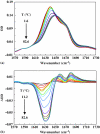Power-law dependence of the melting temperature of ubiquitin on the volume fraction of macromolecular crowders
- PMID: 21385002
- PMCID: PMC3064690
- DOI: 10.1063/1.3556671
Power-law dependence of the melting temperature of ubiquitin on the volume fraction of macromolecular crowders
Abstract
The dependence of the melting temperature increase (ΔT(m)) of the protein ubiquitin on the volume fraction (ϕ) of several commonly used macromolecular crowding agents (dextran 6, 40, and 70 and ficoll 70) was quantitatively examined and compared to a recently developed theoretical crowding model, i.e., ΔT(m) ∼ (R(g)∕R(c))(α)φ(α∕3). We found that in the current case this model correctly predicts the power-law dependence of ΔT(m) on φ but significantly overestimates the role of the size (i.e., R(c)) of the crowding agent. In addition, we found that for ubiquitin the exponent α is in the range of 4.1-6.5, suggesting that the relation of α=3∕(3ν-1) is a better choice for estimating α based on the Flory coefficient (ν) of the polypeptide chain. Taken together these findings highlight the importance of improving our knowledge and theoretical treatment of the microcompartmentalization of the commonly used model crowding agents.
© 2011 American Institute of Physics.
Figures



Similar articles
-
Molecular crowding stabilizes both the intrinsically disordered calcium-free state and the folded calcium-bound state of a repeat in toxin (RTX) protein.J Am Chem Soc. 2013 Aug 14;135(32):11929-34. doi: 10.1021/ja404790f. Epub 2013 Jul 31. J Am Chem Soc. 2013. PMID: 23941183
-
Crowding effects on the mechanical stability and unfolding pathways of ubiquitin.J Phys Chem B. 2009 Jan 8;113(1):359-68. doi: 10.1021/jp807755b. J Phys Chem B. 2009. PMID: 19072020 Free PMC article.
-
Effects of macromolecular crowding on biochemical reaction equilibria: a molecular thermodynamic perspective.Biophys J. 2007 Sep 1;93(5):1464-73. doi: 10.1529/biophysj.107.104646. Epub 2007 May 18. Biophys J. 2007. PMID: 17513384 Free PMC article.
-
Size-dependent studies of macromolecular crowding on the thermodynamic stability, structure and functional activity of proteins: in vitro and in silico approaches.Biochim Biophys Acta Gen Subj. 2017 Feb;1861(2):178-197. doi: 10.1016/j.bbagen.2016.11.014. Epub 2016 Nov 12. Biochim Biophys Acta Gen Subj. 2017. PMID: 27842220 Review.
-
Macromolecular Crowding and DNA: Bridging the Gap between In Vitro and In Vivo.Int J Mol Sci. 2023 Dec 15;24(24):17502. doi: 10.3390/ijms242417502. Int J Mol Sci. 2023. PMID: 38139331 Free PMC article. Review.
Cited by
-
Quantification of excluded volume effects on the folding landscape of Pseudomonas aeruginosa apoazurin in vitro.Biophys J. 2013 Oct 1;105(7):1689-99. doi: 10.1016/j.bpj.2013.08.038. Biophys J. 2013. PMID: 24094410 Free PMC article.
-
Reaching new levels of realism in modeling biological macromolecules in cellular environments.J Mol Graph Model. 2013 Sep;45:144-56. doi: 10.1016/j.jmgm.2013.08.017. Epub 2013 Aug 28. J Mol Graph Model. 2013. PMID: 24036504 Free PMC article. Review.
-
Denatured state structural property determines protein stabilization by macromolecular crowding: a thermodynamic and structural approach.PLoS One. 2013 Nov 12;8(11):e78936. doi: 10.1371/journal.pone.0078936. eCollection 2013. PLoS One. 2013. PMID: 24265729 Free PMC article.
References
Publication types
MeSH terms
Substances
Grants and funding
LinkOut - more resources
Full Text Sources
Research Materials

